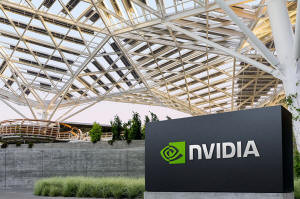Nvidia investor dilemma: how much is too much in a stock portfolio?
 Send a link to a friend
Send a link to a friend
 [July 15, 2024] By
David Randall [July 15, 2024] By
David Randall
NEW YORK (Reuters) - Outsized positions in artificial intelligence
darling Nvidia have boosted portfolio managers' returns this year but
the bets stand to magnify risk if the chipmaker's red-hot shares see a
reversal of fortune.
Nvidia shares are up about 785% since the start of 2023 and have risen
some 160% this year alone, boosted by demand for its chips, seen as the
gold standard in the AI field. Nvidia briefly became the world's most
valuable company in June before a dip in its shares returned that title
to Microsoft.
Asset managers’ holdings of the chipmaker have swelled alongside its
stock price. Morningstar data showed that 355 actively managed funds
held Nvidia positions that totaled 5% or more of their assets at the end
of the first quarter, compared to just 108 funds in the same period last
year. Funds can maintain large positions in a single holding for a
variety of reasons, whether to maximize profits or to track a stock’s
weight in an index to which the fund is benchmarked.
“There's a mindset among some portfolio managers that they missed the
boat on Apple or Microsoft and they don't want to be wrong on AI," said
Jack Shannon, a senior Morningstar analyst. "They don't want to sell.”
The oversized positions in Nvidia are another example of how investors
have cast their lots with a handful of massive growth stocks, leading to
one of the most concentrated market advances ever. Nvidia alone has
accounted for around a third of the S&P 500’s nearly 17% gain this year,
according to S&P Dow Jones Indices.
Overall, markets are the third-narrowest since 1986, with only 24% of
stocks in the S&P 500 outperforming the index in the first half,
according to BofA Global Research strategists.
Funds that owned Nvidia have so far reaped the benefits.
Actively-managed U.S. equity funds that held the stock were up 16.3% on
average over the first six months of 2024, compared with an average 5.7%
return among those that did not own Nvidia, Morningstar data showed.
Yet concentration in a single stock can hurt investors if Nvidia shares
hit a rough patch. While the average price target for the stock among
analysts stands at $133.45, some 3% above its current level, according
to LSEG data, some market participants point to increasing competition,
an expected balance between supply and demand as Nvidia ramps up
production, and the company's rich valuation as possible reasons for a
downturn.

The stock trades at 39.3 times forward earnings, about 50% more than its
industry median, according to LSEG.
[to top of second column] |

The logo of NVIDIA as seen at its corporate headquarters in Santa
Clara, California, in May of 2022. Courtesy NVIDIA/Handout via
REUTERS /File Photo

“Does having 6% or more of your portfolio in one stock create
outsized risks? The answer is obviously, yes,” said Phil Orlando,
chief equity market strategist at Federated Hermes. “The fact that
one stock did take off like a rocket ship doesn’t mean that it was
smart ... to have that many eggs in one basket.”
Investors got a taste of how concentrated positions can be a two-way
street last week, following a sharp, one-day rotation out of Big
Tech stocks sparked by cooler inflation data. Nvidia fell nearly 6%
on Thursday, its biggest daily drop in more than two weeks, while
the tech-heavy Nasdaq 100 lost about 2.2%. Both pared those losses
the following day.
‘TWINGE OF REGRET’
Technology-sector funds overall have the largest weightings in
Nvidia, with four Fidelity funds each holding more than 18% of their
assets in the stock, according to Morningstar. Yet other, more
diversified, funds appear to be taking on similar risks, with the
Baron Fifth Avenue Growth fund holding nearly 15% of its portfolio
in Nvidia and the Fidelity Blue Chip Growth fund holding about 13%
of its portfolio in the stock. Both firms declined to comment.
Anthony Zackery, a portfolio manager at Zevenbergen Capital
Investments, has owned Nvidia since 2016 and continues to maintain a
core position, though he has trimmed it periodically to keep within
his firm’s risk-tolerance guidelines. The fund can hold as much as
13% of one stock in growth portfolios to keep in line with
weightings in its benchmark, the Russell 3000 Growth Index.
"This is a company that is at the forefront of the next trend in
technology," he said.
Some who sold out entirely, on the other hand, wish they had held on
longer.
Kevin Landis, chief investment officer at Firsthand Capital
Management, said he was "prudent" and took profits in 2020 in a
Nvidia position he owned for several years. Still, he can’t help
thinking about the gains he missed out on.
"I can’t look at any of my screens now without feeling a twinge of
regret," he said.
(Reporting by David Randall; Editing by Ira Iosebashvili and Rod
Nickel)
[© 2024 Thomson Reuters. All rights
reserved.]
This material may not be published,
broadcast, rewritten or redistributed.
Thompson Reuters is solely responsible for this content. |